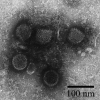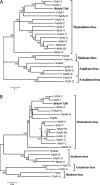Host range, prevalence, and genetic diversity of adenoviruses in bats
- PMID: 20089640
- PMCID: PMC2849498
- DOI: 10.1128/JVI.02497-09
Host range, prevalence, and genetic diversity of adenoviruses in bats
Abstract
Bats are the second largest group of mammals on earth and act as reservoirs of many emerging viruses. In this study, a novel bat adenovirus (AdV) (BtAdV-TJM) was isolated from bat fecal samples by using a bat primary kidney cell line. Infection studies indicated that most animal and human cell lines are susceptible to BtAdV-TJM, suggesting a possible wide host range. Genome analysis revealed 30 putative genes encoding proteins homologous to their counterparts in most known AdVs. Phylogenetic analysis placed BtAdV-TJM within the genus Mastadenovirus, most closely related to tree shrew and canine AdVs. PCR analysis of 350 bat fecal samples, collected from 19 species in five Chinese provinces during 2007 and 2008, indicated that 28 (or 8%) samples were positive for AdVs. The samples were from five bat species, Hipposideros armiger, Myotis horsfieldii, M. ricketti, Myotis spp., and Scotophilus kuhlii. The prevalence ranged from 6.25% (H. armiger in 2007) to 40% (M. ricketti in 2007). Comparison studies based on available partial sequences of the pol gene demonstrated a great genetic diversity among bat AdVs infecting different bat species as well as those infecting the same bat species. This is the first report of a genetically diverse group of DNA viruses in bats. Our results support the notion, derived from previous studies based on RNA viruses (especially coronaviruses and astroviruses), that bats seem to have the unusual ability to harbor a large number of genetically diverse viruses within a geographic location and/or within a taxonomic group.
Figures





Similar articles
-
Molecular Detection and Phylogenetic Characterization of Bat and Human Adenoviruses in Southern China.Vector Borne Zoonotic Dis. 2016 Jun;16(6):423-7. doi: 10.1089/vbz.2015.1892. Epub 2016 Apr 8. Vector Borne Zoonotic Dis. 2016. PMID: 27057618
-
[Genetic diversity of adenoviruses in bats of China].Bing Du Xue Bao. 2012 Jun;28(4):403-8. Bing Du Xue Bao. 2012. PMID: 22978165 Chinese.
-
Surveillance for Adenoviruses in Bats in Italy.Viruses. 2019 Jun 6;11(6):523. doi: 10.3390/v11060523. Viruses. 2019. PMID: 31174292 Free PMC article.
-
Evolution and Cryo-electron Microscopy Capsid Structure of a North American Bat Adenovirus and Its Relationship to Other Mastadenoviruses.J Virol. 2017 Jan 3;91(2):e01504-16. doi: 10.1128/JVI.01504-16. Print 2017 Jan 15. J Virol. 2017. PMID: 27807242 Free PMC article.
-
Adenoviruses across the animal kingdom: a walk in the zoo.FEBS Lett. 2019 Dec;593(24):3660-3673. doi: 10.1002/1873-3468.13687. Epub 2019 Dec 9. FEBS Lett. 2019. PMID: 31747467 Review.
Cited by
-
Co-circulation of diverse paramyxoviruses in an urban African fruit bat population.J Gen Virol. 2012 Apr;93(Pt 4):850-856. doi: 10.1099/vir.0.039339-0. Epub 2011 Dec 28. J Gen Virol. 2012. PMID: 22205718 Free PMC article.
-
Bat guano virome: predominance of dietary viruses from insects and plants plus novel mammalian viruses.J Virol. 2010 Jul;84(14):6955-65. doi: 10.1128/JVI.00501-10. Epub 2010 May 12. J Virol. 2010. PMID: 20463061 Free PMC article.
-
A potential bat adenovirus-based oncolytic virus targeting canine cancers.Sci Rep. 2021 Aug 18;11(1):16706. doi: 10.1038/s41598-021-96101-4. Sci Rep. 2021. PMID: 34408176 Free PMC article.
-
Evaluation of bat adenoviruses suggests co-evolution and host roosting behaviour as drivers for diversity.Microb Genom. 2021 Apr;7(4):000561. doi: 10.1099/mgen.0.000561. Microb Genom. 2021. PMID: 33871330 Free PMC article.
-
Emerging infectious diseases associated with bat viruses.Sci China Life Sci. 2013 Aug;56(8):678-82. doi: 10.1007/s11427-013-4517-x. Epub 2013 Aug 7. Sci China Life Sci. 2013. PMID: 23917838 Free PMC article. Review.
References
-
- Aderem, A., and D. A. Hume. 2000. How do you see CG? Cell 103:993-996. - PubMed
-
- Barouch, D. H., M. G. Pau, J. H. Custers, W. Koudstaal, S. Kostense, M. J. Havenga, D. M. Truitt, S. M. Sumida, M. G. Kishko, J. C. Arthur, B. Korioth-Schmitz, M. H. Newberg, D. A. Gorgone, M. A. Lifton, D. L. Panicali, G. J. Nabel, N. L. Letvin, and J. Goudsmit. 2004. Immunogenicity of recombinant adenovirus serotype 35 vaccine in the presence of pre-existing anti-Ad5 immunity. J. Immunol. 172:6290-6297. - PubMed
-
- Benkö, M., and B. Harrach. 2003. Molecular evolution of adenoviruses. Curr. Top. Microbiol. Immunol. 272:3-35. - PubMed
-
- Chua, K. B., G. Crameri, A. Hyatt, M. Yu, M. R. Tompang, J. Rosli, J. McEachern, S. Crameri, V. Kumarasamy, B. T. Eaton, and L. F. Wang. 2007. A previously unknown reovirus of bat origin is associated with an acute respiratory disease in humans. Proc. Natl. Acad. Sci. U. S. A. 104:11424-11429. - PMC - PubMed
Publication types
MeSH terms
Substances
Associated data
- Actions
- Actions
- Actions
- Actions
- Actions
- Actions
- Actions
- Actions
- Actions
- Actions
- Actions
- Actions
- Actions
- Actions
- Actions
- Actions
- Actions
- Actions
- Actions
- Actions
LinkOut - more resources
Full Text Sources
Miscellaneous

